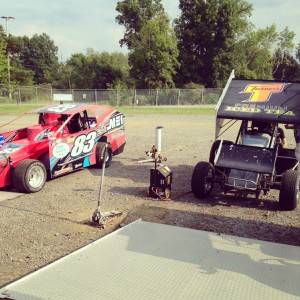Last night, we were fortunate enough to be able to attend the Lou Blaney Memorial at Sharon Speedway. Having grown up watching Lou and my uncle, Brian Swartzlander, go toe-to-toe for years in our local modified division, I’m happy to be able to be a part of an event that honors him every year.
It’s probably not surprising that Lou’s hotshoe sons, Dave and Dale, were able to dominate the field

Perfect pit situation last night at the Lou Blaney Memorial, although we were extremely far from the concession stands. My life is so hard. (More evidence on instagram.com/kswartzlander)
and earned first and second place honors, respectively. Dave started in the third position and it was clear from early on that he had the car to beat.
From the moment Dave took the green, and then the lead on lap six, I noticed most fans with their eyes darting back and forth between the brothers’ cars, watching to see what line they would take and what potential struggle lapped traffic would give them. Dale made his way into second place on lap 15 but didn’t give his teammate a challenge. That didn’t stop most from keeping their eyes glued to the pair, following the action and giving a rousing ovation at the finish.
Watching that race, and watching the fans’ reaction, it was really clear how much of the excitement of racing is tied to a story. Yes, Dave’s impressive performance would have been entertaining whether or not he was Lou’s son. But the added hook of racing against his brother to win the race held in his father’s honor – for the first time, no less – was enough to keep everyone on their edge of their seats.
Talking to drivers and crew in the pits and at different events, I hear a lot of the same complaint. Many people feel that they can’t compete off the track with the ‘successful’ drivers – the ones with the fastest and best-looking cars.
But knowing the story behind that driver, car, team owner, track or any other ‘character’ in the pits gives racing life. That’s why people who don’t know the stories think racing is just rednecks making left turns.
They don’t know what we do about our people.
That’s why it’s so important to share your story when you get the chance. Do it to:
- Sell sponsorship
- Get media coverage
- Build a fan base
- Sell apparel, and
- (most importantly) be someone that other people can relate to and care about.
Before you point out that the story I just gave you is one about the front of the field – and all about on-the-track performance – let’s talk about another, perhaps more relatable example.
Sprint car chassis builder Eagle Motorsports does a great job of telling a story that appeals to their audience on social media. One of my favorite pieces of their content is their #WeldWednesday feature – a weekly picture of the beautiful welds that you’ll find on their cars.
Most people don’t care about the welds on a frame – they just want them to stay together and not flex out. But welding aficionados appreciate craftsmanship – and Eagle is telling the story of their talented welders through their products. It’s a detail that comes to life, and something that might set them apart for a small percentage of their audience. But that percentage? I would bet they’re fiercely loyal.
Telling a story doesn’t mean telling us what you had for lunch every day, unless your story is that you’re a Paleo chef. Or a gluten-free baker – something that you don’t see every day in racing.
It means sharing what you love and are passionate about. It’s means showing people what you enjoy and what helps other people relate to you, in person and on social media. Sometimes it means giving news; other times it’s sharing your struggles (read: not crying poor).
Telling your story means having the conversations you’d have in real life, because this is real life, whether it’s in person or on social media.
Because your people want to know you.
Xo. Kristin
P.S. Ever shared something you were nervous about, or thought ‘I’d never put that out there?’ Feel free to comment below for a little extra sharing love <3

